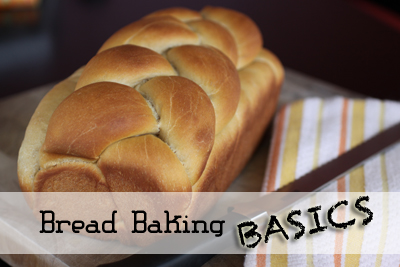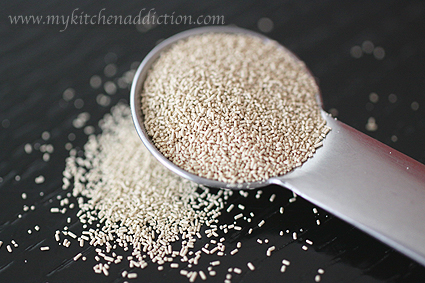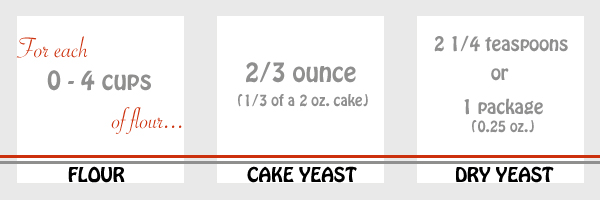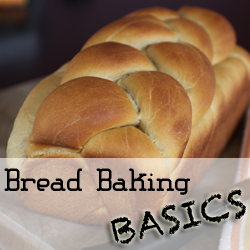 For a lot of people (many of you who leave comments!), when it comes to baking bread, it seems like “yeast” is a bad word. Well, I’m here to change that!
For a lot of people (many of you who leave comments!), when it comes to baking bread, it seems like “yeast” is a bad word. Well, I’m here to change that!
As I mentioned last week, I have decided to write a mini-series on the basics of bread baking… I’m hoping to take the fear and frustration out of baking homemade bread. It’s something I have learned to love, and I think that many of you will learn to love it, too. Plus, it’s a great way to save money and keep an eye on the quality of the ingredients that go into the food your family eats!
Last week, I covered the basic “equipment” that I use when I bake bread… After all, having the right tools makes a big difference! This week, as you may have guessed, I’m going to talk about yeast. Don’t go running off just yet… It won’t be painful, I promise!
Week 2 – Yeast
When I first started baking, I would skip over every recipe that called for yeast. Just the thought of it scared me… What if I bought the wrong kind? What if my water was too hot? What if my dough wouldn’t rise?
I’m sure many of those questions have crossed your mind in the past… And, you may even have had some bad experiences. I have, too! Today, I’m hoping we can put all of that behind us and start out fresh. I’m going to share what works for me when it comes to baking with yeast, and I’m hoping it will work for you, too!

Types of Yeast
The first thing to address when we start talking about yeast is that there are different types of yeast. This was mistake #1 for me when I started baking with yeast. I attempted to substitute dry active yeast for fresh cake yeast in a recipe… Let’s just say things didn’t turn out so well. And, I ended up running to the store at the last minute to buy some bread!
So, let’s talk about the three types of yeast…
- Fresh (Wet) Cake Yeast– You probably won’t find fresh yeast at your local grocery store… It’s typically sold at specialty markets. It comes in a compressed cake (typically 2 ounces) and can be mixed in with dry ingredients or dissolved into wet ingredients in your recipe.
- Active Dry Yeast– Active dry yeast can be found at most grocery stores and is very versatile. Typically, active dry yeast is dissolved into wet ingredients in your recipe with a little bit of sugar to help get the yeast going. It’s best if the liquids are warm, but not hot – 110-115°F.
- Instant Dry Yeast– Much like active dry yeast, instant dry yeast can be found at most grocery stores. It is sometimes called “fast rising” and it does shorten the time required for dough to rise. It’s not recommended, though, for doughs that will be refrigerated or frozen.
So, now we know that there are three different types of yeast. Sounds complicated, doesn’t it? Here’s my recommendation… Learn to use one and use it well!
My preference is Red Star Active Dry Yeast. I find that it is readily available and is very versatile, so it works well for me!
Note – Brewer’s Yeast and Nutritional Yeast are different… They’re not used for leavening bread.
Conversions
You’re probably thinking, “Alright, so if I only use active dry yeast, how can I make a recipe that calls for fresh yeast?” It’s a valid question! Fortunately, you can substitute one for the other… You just have to know the conversions…

(Information for the chart came from this conversion chart from Red Star Yeast)
So, for each 0 – 4 cups of flour in a recipe, you will need 2 1/4 teaspoons (or one 0.25 oz. package) of dry yeast (either active or instant) or 2/3 of an ounce of cake yeast. That’s simple enough, right?
I used this conversion to adapt my grandmother’s roll recipe (which called for cake yeast), and it worked beautifully! Also, when in doubt, I often go a bit shy on the dry yeast and just allow my dough to rise a little while longer.
Storage
I like to buy my active dry yeast in bulk so I don’t have to be bothered with lots of little packages of yeast. I bake bread a lot! I find that it is easiest to store it in an airtight container in the freezer because it lasts the longest that way (up to 6 months!).
Working with Yeast
There are a lot of different ways to incorporate yeast into a recipe… And, the way your dough will rise will be affected by a lot of different factors – the weather, your ingredients, how well the dough was kneaded, the day of the week (OK, I guess the yeast doesn’t have any idea of what day of the week it is, but you never know!). The point is, there’s no single way to bake with yeast, and my best advice is to find a few recipes that you really like and learn from them. To bake bread successfully, you just need to get a feel for it… Practice makes perfect. That’s how I learned!
That said, unless a recipe specifies otherwise, here’s how I typically work yeast into my bread dough recipes…
- Begin with the liquids (typically milk or water)… They should be warm to the touch, but not hot. You can use a thermometer to make sure they’re between 110-115°F, but I honestly just usually test with a (clean) finger.
- Dissolve the yeast in the liquid with a small amount of sugar (or whatever the recipe calls for).
- Add the remaining wet ingredients and whisk to combine.
- Add the flour and any other dry ingredients, working in gradually until the dough pulls away from the sides of the bowl.
- Knead until smooth.
- Cover and let rise.
Of course, I cannot cover everthing in a single blog post… I am just dealing with some of the basics. Feel free to leave any questions you may have in the comments or ask me on Twitter, and I will do my best to answer them!
Here are a few more great resources for baking with yeast…
Next Week… Mixing Without the Mess
One of the things that I found to be most intimidating about bread baking was the mess… I had visions of flour sprinkled all over my kitchen and a sink full of sticky, messy bowls. Next week, I’ll share my tips for how to successfully mix up a batch of bread dough without a giant mess!
Please Note – Red Star Yeast has not compensated me for this blog post… I just happen to love baking with their active dry yeast!



Jen, I’m working on overcoming my fear of yeast with your help. Step One was your Grandmother’s dinner rolls. They were perfection.
Hi Jen, thanks for posting this and sharing all the yeast info. Hope you’re having a great day.
Kristy
I find that my yeast is downright cranky on Mondays so I don’t even bother. ;-)
I love this series of posts, Jen!! Keep ’em coming!
Hi! I’ve never had a fear of working with yeast. Born and raised in Michigan, I always get beautiful bread when I bake in the Great Lakes State. However, since marrying and moving to Australia, the yeast doesn’t work the same in the Land Down Under. My bread always ended up like a brick no matter what I did. I’m still trying to figure out how to adjust the yeast to the Southern Hemisphere.
Yeast is your friend! I wish everyone would bake more with yeast, it’s an experience. Love this tutorial, you’re great at explaining in such an approachable way!
Ah, perfect. I need a handy conversion chart like this.
Great tutorial Jen! I love that you are trying to take the intimidation out of baking with yeast, and SO happy that you are using RED STAR Yeast :)
Beautifully informative :)
Thanks for the clarification. This is really helpful. I can’t wait to read the other posts on this subject.
~Kimberlee
{Disposing of Sewing Needles}
Actually, fresh yeast is readily available in many countries outside of the U.S. One doesn’t have to go to specialty stores. Otherwise, thanks for the tips! Even though I am comfortable making breads, I never tire about reading about the process and vital ingredients.
Ok, were you reading my mind just now? but you do make it sound a little less daunting and I do want to give the whole yeast thing another shot. Fingers crossed!
Great information! This is something I wish I had when I was learning to bake with bread…and still great to have as a refresher!
I cannot even begin to tell you how scared I am of yeast….eek!
When making dough for two loaves of bread, can you divide the dough before the first rise so the bowl doesn’t have to be as big?
Elliejo – Yes, I believe you could do that. I typically do not, but I don’t see any reason why it wouldn’t work. Just be careful to knead well and divide the dough evenly.
THANK YOU….THANK YOU….THANK YOU….You’ve taken the FEAR out of baking for me….I want to teach and do some baking with my grand daughter she’s 7, and I think she would enjoy learning and baking with me now since I now have a clearer picture of baking with yeast.
I’ve had several unsuccessful attempts at baking bread. I think it has to do with the temperaturature of the water where the yeast is dissolved. I actually boiled water and added it to cold this time to get warm water. Then I added the yeast. Question: should the yeast be bubbling or have I killed it? I don’t know how to recognize a successful attempt. I prefer not to waste another 7 cups of flour. Since I read the temperature recommendation afterwards – – can you describe the look of a successful combination? Should I see bubbling? I’m not and am wondering if I need another trip to the store. Thank you
Hi, Rose – Great question! Typically, you want the water to be warm, but not boiling. Most recipes using active dry yeast will call for water to be around 120F. If the water is too hot, it will kill the yeast. If you want to test your yeast, you can sprinkle some on warm water and let it sit for about 10 minutes. It should be a bit foamy, but it won’t really “bubble”.
For more detailed information, check out this page from Red Star Yeast that has directions on how to test your yeast and use it in recipes. Hope that helps!
I’ve had several unsuccessful attempts at baking bread. I think it has to do with the water temp where the dry active yeast is dissolved. Question: Should the yeast be bubbling or if it isn’t have I killed the yeast? I don’t know how to recognize a successful attempt, should I see bubbling?
Thanks, very well written article on yeast . Would making a whole wheat flour bread would need more quantity of yeast as compared to plain flour ?